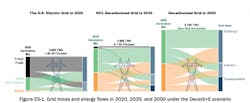What Role Do Microgrids Play in the Biden Administration’s 40% Solar Vision?
A new Department of Energy (DOE) report, which finds that solar could account for about 40% of the US electricity supply by 2035, offers a vision of the role microgrids would play on an increasingly renewable grid.
“We can no longer look at solar technologies in isolation — we must look at how they interact with the full energy system,” Becca Jones-Albertus, director of the DOE’s Solar Energy Technologies Office, said in an introduction to the Solar Futures Study released Sept. 8.
“Technologies like power electronics and storage have the potential to reshape how energy is produced and consumed, enabling renewable microgrids that can keep the lights on after a major storm or shift energy consumption to maximize cost savings,” Jones-Albertus said.
Credit: Solar Futures Study, US DOE
The Solar Futures Study found that solar could account for about 40% of the US electricity supply by 2035 — up from about 4% today — with sharp cost reductions, supportive policies and large-scale electrification.
However, to reach that level, solar would need to grow by about 30,000 MW a year through 2025, climb to 60,000 MW annually for the next five years and then ramp up to 100,000 MW by 2035, according to the report. To put the scale of that ambition in perspective, about 15,000 MW of solar was installed last year in the US.
Careful planning needed
The DOE researchers cautioned that maintaining reliability in a grid powered mainly by renewable energy requires careful power system planning.
“Small-scale solar, especially coupled with storage, can enhance resilience by allowing buildings or microgrids to power critical loads during grid outages,” the researchers said. “In addition, advances in managing distributed energy resources, such as rooftop solar and electric vehicles, are needed to integrate these resources efficiently into electricity distribution systems.”
On the issue of grid resilience, the report notes the resilience value of solar can be increased through energy storage and load flexibility.
“Further, groups of resilient buildings can be integrated into microgrids: clusters of buildings that are interconnected to the grid but capable of operating independently,” the DOE researchers said.
Putting a value on resilience
Grid resilience research priorities for the DOE include how best to value solar and grid resilience, according to the report.
“Because advanced inverters and controls to enable grid islanding may entail a cost premium over less resilient alternatives, regulated utilities may have difficulty gaining approval for their use without a clear mandate to invest in resilience,” the DOE researchers said.
Also, the regulatory environment limits the ability of nonutility entities to develop microgrids that serve multiple customers, they noted.
There is a growing effort to characterize the willingness of individuals, companies or grid operators to pay for resilience, but it is not always clear how those payments should be spread across consumers who benefit from resilience differently, the researchers said.
Microgrids can be part of evolving grid
The researchers said that as microgrid technology improves and experience in operating islanded systems grows, there may be opportunities to move from a traditionally integrated system with microgrids at select locations to a grid that can flexibly isolate different segments.
“In the event of a widespread blackout, sections of the grid close to generation might be able to isolate themselves and use available power, even if those loads are not in an established microgrid with that generation,” the researchers said.
Join us at Microgrid California, a one-day educational forum on Oct. 5 in Foster City, California. Registration is now open.
